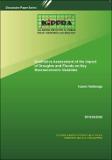| dc.description.abstract | Adverse weather conditions have become more prevalent all over the world
with devastating impact on economies. In Kenya, weather conditions are
manifested in frequent occurrence of droughts and floods, and while droughts
are widespread throughout the country, floods tend to be localized. The economic
effects of droughts and floods are manifested in the disruption of production
flows, resulting in production losses, income losses, loss of employment and
increased operational costs. Droughts and floods do not occur in isolation and at
times occur alongside other events, such as political unrest, high international
commodity prices, etc. In this study, we identify patterns of disruption of
production flows, decline in revenues and higher operational costs that typify
disaster periods. Results show that the macroeconomic imbalances that result
from drought and floods, though temporary in nature, arise either directly from
the disasters and/or from governments’ effort to mitigate the economy against
the negative effects of the disasters. These impacts are manifested in increased
government expenditure targeted at building resilience and mitigation measures,
reduced government revenue from a decline in tax revenue collections, increased
imports of food stuffs and price increases. | en |

